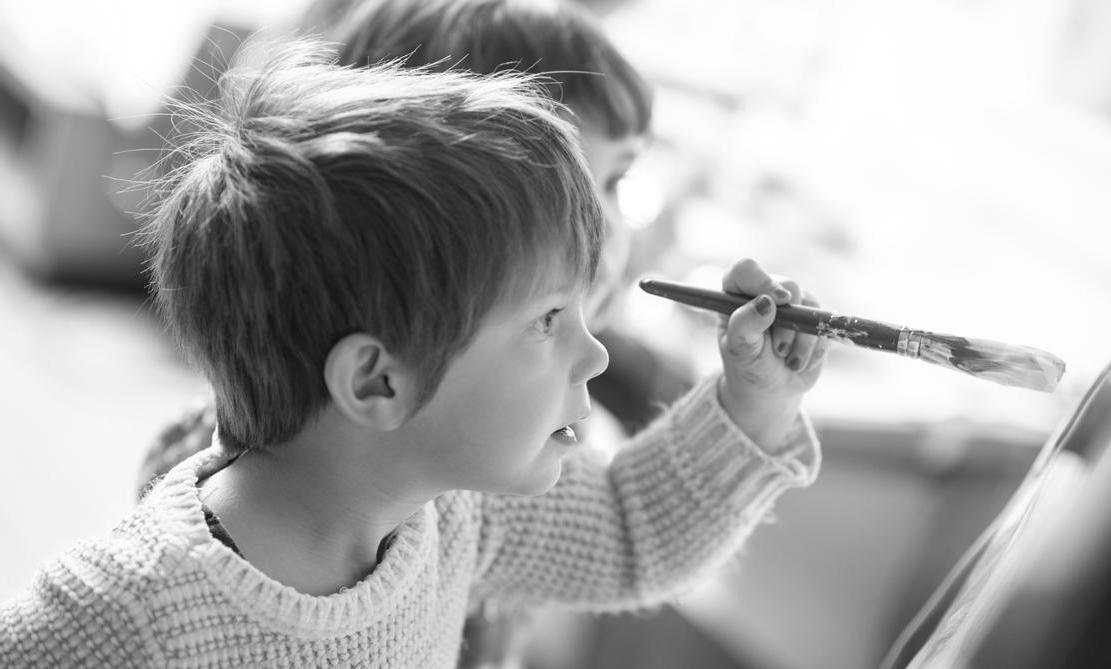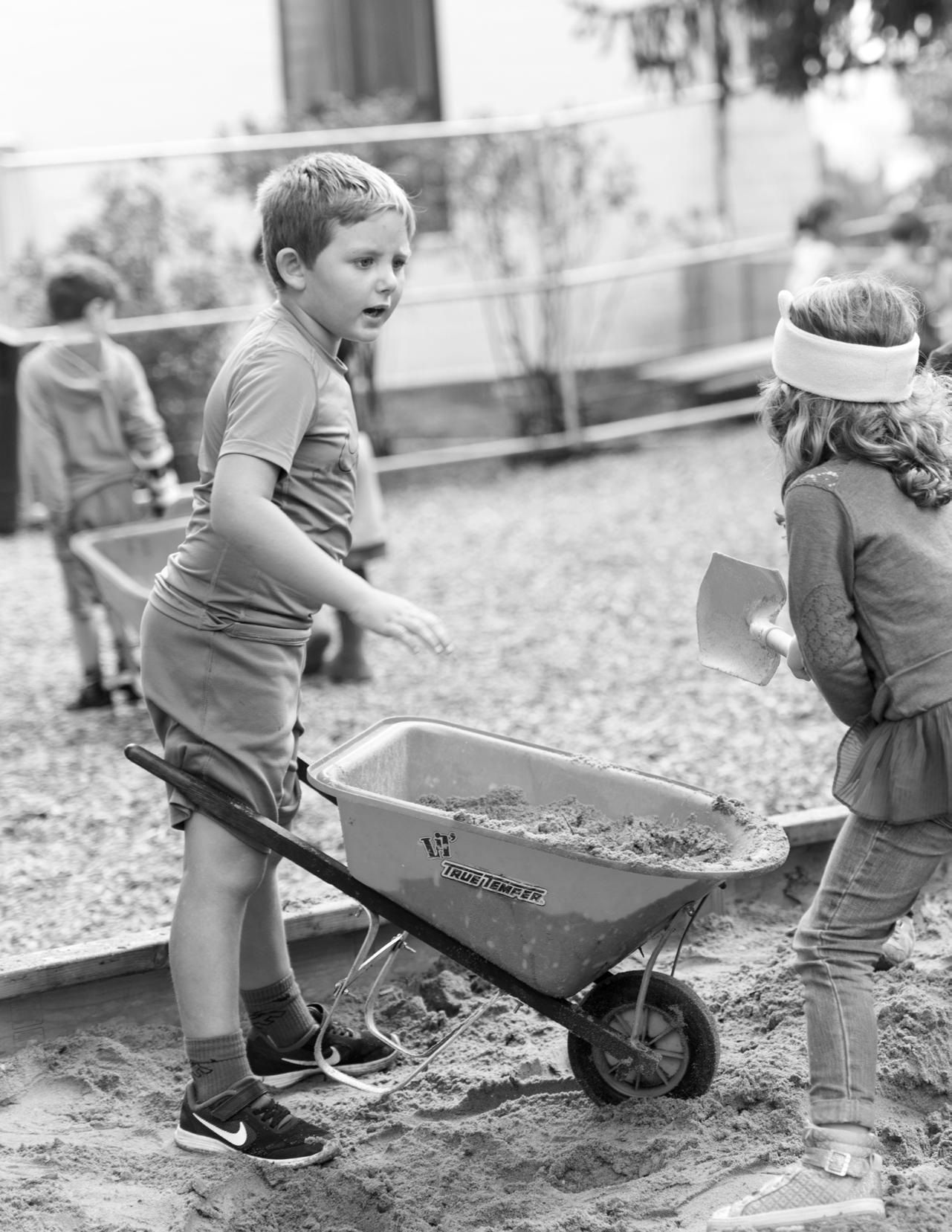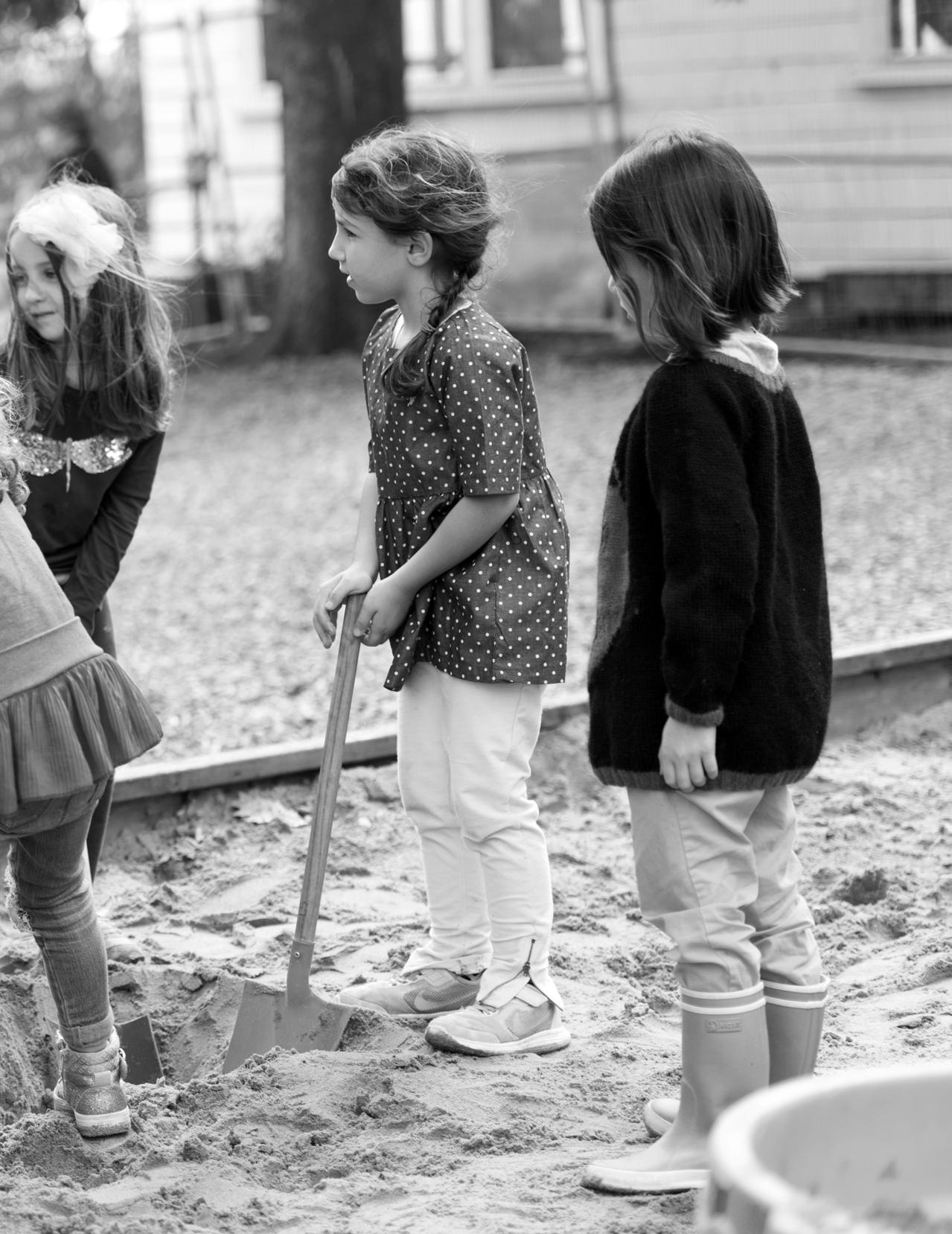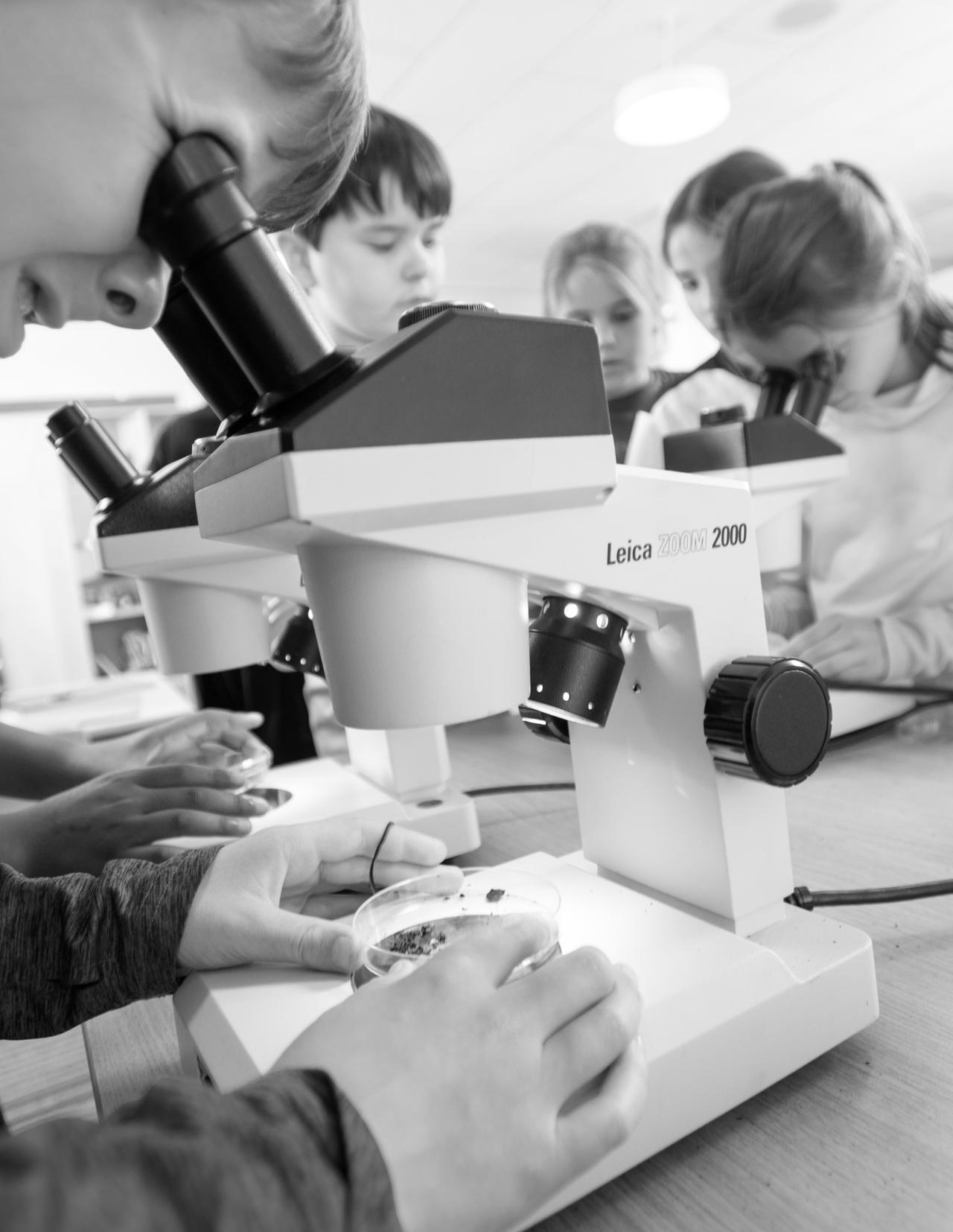
6 minute read
Kindergarten–Grade 1
The primary goals of our K–1 program are for children to develop self-confidence, a love for learning, and a respect and appreciation for themselves, others, and their environment. We emphasize the development of both academic and social skills and encourage children to cooperate with each other, make choices, and take responsibility for their own learning. The curriculum is designed to accommodate the wide range of learning styles and skill levels that children bring to the classroom. Diverse learning opportunities are presented in a supportive, stimulating, and creative experiential setting. Individual, small-group, and wholeclass activities are employed throughout the day.
Language Arts
Advertisement
Listening enjoy stories, poetry, rhyming, and playing with sounds of language, listen and respond appropriately to others, follow multistep directions, match letters to sounds, and hear and remember stories and other information.
Speaking exhibit ability to verbalize needs, recite chants and poetry with the group, share ideas and experiences, dictate stories with a beginning, middle, and end, join discussions with relevant comments, and discuss stories with attention to sequence and detail.
Reading enjoy stories and poetry, distinguish upper- and lowercase letters, recognize consonant sounds, recognize short and long vowel sounds, recognize initial and final consonant blends, read primers, begin to read chart stories, choose to look at books in their own free time, read their own writing, recognize sight words, use picture clues, strengthen receptive and expressive vocabulary, use context clues, and comprehend and discuss stories at a literal level.
Writing dictate continuous stories with several events in sequence, generate varied ideas for written expression, expand stories with details, print uppercase letters, print lowercase letters, use phonetic spelling, build knowledge of conventional spelling, begin to understand the conventions of capitalization and punctuation, write legibly, and begin to write rhyming and non-rhyming poetry.
Mathematics
Number Sense use math manipulatives purposefully, recognize all numerals, understand that numbers have many uses, understand what numbers mean, count using one-to-one correspondence, order, compare, read, and begin to apply place value for numbers up to 100, and begin to understand the concept of fractions.
Computation use and apply estimation, understand addition and subtraction facts with sums and differences through 10, add two-digit numbers without regrouping, and subtract two-digit numbers without regrouping.
Data Analysis collect and interpret tallies and graphs, and read and interpret simple graphs.
Geometry describe, model, and classify shapes, and describe the relationship of two or more objects using positional words (e.g., over, under, to the right).
Measurement estimate and measure length, time, weight, and capacity using standard and nonstandard measuring tools, understand calendar concepts, tell time by the hour and half hour using an analog clock, recognize the values of pennies, nickels, and dimes, and add the values of pennies, nickels, and dimes.
Patterns and Relationships recognize, describe, extend, and create various simple patterns, and skip-count by 2, 5, and 10.
Math Communications print numerals, classify objects into two or more groups using attributes, understand a continuum of one attribute in many objects, use a procedural list such as directions or a recipe, and solve simple word problems.
Social Studies
recognize personal strengths and uniqueness and develop appreciation for those of peers, identify and practice rights and responsibilities of group membership, learn how people in Maine and elsewhere adapt to their rural/urban environment, understand how food products get from farm to table, experience the exchange of goods and use of currency at a market, understand oral tradition and how it produced many versions of familiar folktales, recognize how myths and folklore can serve to explain natural phenomena and impart cultural values, celebrate the contributions and explore the history of various ethnic groups, recognize and respect similarities and differences in another culture studied in depth (Global Studies), develop beginning map skills, and practice voting as a means of understanding democratic decision-making.
Science
Life Science observe, question, and predict various aspects of the life cycle of several animals and plants, study the adaptations of plants and animals to seasonal changes and varied climates, experiment with plants growing under varied conditions, study the structure of human and other animal skeletons and begin to understand how they function, and analyze the relationship between proper nutrition and the well-being of living things. Physical Science study the relative properties of various materials through experience with sand, water, play dough, clay, etc., use scales for experiments and to develop the concept of balancing, explore magnetism by experimenting with magnets to find materials that are attracted to each other, experience physical changes in ingredients during cooking projects, design and construct models, structures, and environments, identify and experiment with the various states of matter (solids, liquids, and gases), examine the relationships among light, objects, and shadows through experimentation and observation, learn the characteristics of different climates, and observe the structure and properties of various types of soil. Visual Arts
Creative Expression understand that visual arts may be used to express narrative and emotions, combine shapes and lines to draw recognizable images, use and understand the individual properties of paints, know how to mix secondary colors from primary colors, thoughtfully utilize page composition, make a sculpture or container from clay, and explore printmaking.
Aesthetics describe specific visual aspects seen in the artwork of others, describe objects in terms of color, texture, shape, size, and narrative, know that artwork can express intangibles such as feelings, and analyze historical and contemporary works of art.
Arts and Cultural Heritage recognize common subjects, styles, and techniques of the arts from different cultures or ethnic groups, create original works that integrate characteristics from different cultures, including the students’ own communities, and explore why artists make art in different ways.
Music
move to a steady pulse, learn simple circle games and circle and line dances, echo short rhythmic and melodic phrases, begin to develop vocabulary to describe musical terms, distinguish between fast/slow, long/short, same/different, and high/low, distinguish between speaking and singing voices, sing with a variety of accompaniments, perform using dynamics (loud/soft), sing partner songs and rounds, recognize and respond to changes between duple and triple meters, respond to changes in tempo, rhythm, and texture through movement, perform a steady beat on percussive instruments, play classroom percussive and melodic instruments, create and perform ostinato patterns, create instrumental accompaniments for songs, poems, etc., improvise melodies using proper singing voice, experience various musical styles and cultures, and begin to identify musical forms.
Creative Movement
communicate concepts and ideas through movement, develop freedom of movement and expression with and without limitations, relate movement explorations in the dance space to classroom themes of study, develop a sense of physical well-being and flexibility, strengthen muscular coordination and motor skills, and develop basic locomotor and axial movements in isolation and combination. Students may take Creative Dance classes in the afterschool Enrichment program (for an additional fee).
Physical Education
identify physical changes that occur during vigorous activity, perform appropriate warm-up activities, engage in moderate to vigorous physical activity, study and practice basic elements of movement, including space, shape, force, and rhythm, move with an awareness of space and others’ safety, develop locomotor skills (e.g., running, jumping, skipping), build non-locomotor skills (e.g., bending, stretching, rolling), improve form with sports equipment (e.g., balls, beanbags, paddles), identify the rules of a given activity, demonstrate the ability to cooperate with peers, and use equipment responsibly. Health
demonstrate personal hygiene skills, demonstrate safety skills appropriate to different situations (e.g., classroom, street, bus), differentiate between safe and harmful substances found at home and school, learn habits to prevent the spread of head lice, know how to call for help in an emergency, demonstrate knowledge of food groups and recognize that nutritious food provides fuel for the body, and build effective interpersonal communication and problem-solving skills.
Spanish
In addition to a weekly general meeting where students learn vocabulary through songs, movement, and games, Spanish class is held once a week with advisors in students’ “habitats.” These smaller groups allow for more individualized instruction and provide the opportunity to review vocabulary taught in the general meeting. Students use various materials to practice writing and identifying Spanish words. They also create crafts in conjunction with cultural studies.







